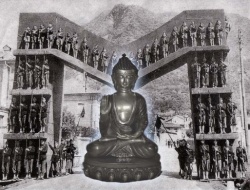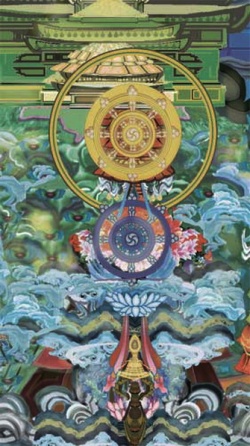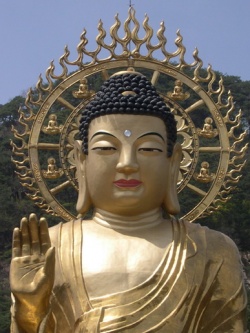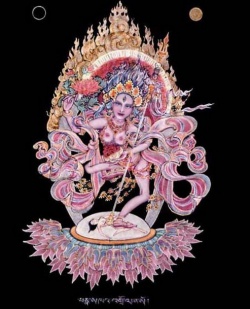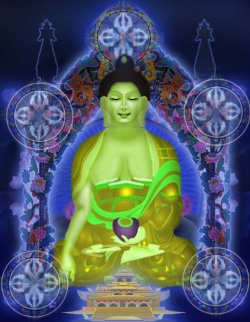Empty Subject Terms in Buddhist Logic: Digna¯ga and his Chinese Commentators by Zhihua Yao
<poem>
Abstract; The problem of empty terms is one of the focal issues in analytic philosophy. Russell’s theory of descriptions, a proposal attempting to solve this problem, attracted much attention and is considered a hallmark of the analytic tradition. Scholars of Indian and Buddhist philosophy, e.g., McDermott, Matilal, Shaw, and Perszyk, have studied discussions of empty terms in Indian and Buddhist philosophy.
But most of these studies rely heavily on the Nya¯ya or Navya-Nya¯ya sources, in which Buddhists are portrayed as opponents to be defeated, and thus do not truly reflect Buddhist views on this issue.
The present paper will explore how Digna¯ ga, the founder of Buddhist logic, deals with the issue of empty subject terms.
His approach is subtle and complicated.
On the one hand, he proposes a method of paraphrase that resembles Russell’s theory of descriptions.
On the other, by relying on his philosophy of language—the apoha theory, he tends to fall into a panfictionalism.
Through the efforts of his follower Dharmakı¯rti, the latter approach would become more acceptable among Indian and Tibetan Buddhists.
Digna¯ ga’s Chinese commentators, who were free from the influence of Dharmakı¯rti, dealt with the empty term issue in three ways:
(1) by adhering to Digna¯ ga’s method of paraphrase;
(2) by allowing exceptions for non-implicative negation; and
(3) by indicating the propositional attitude of a given proposition.
Among these, the third proved most popular.
Keywords Digna¯ga Æ Empty terms Æ Paraphrase Æ Conceptual subjects Æ Negation Æ Propositional attitude Z. Yao (&)
Department of Philosophy, The Chinese University of Hong Kong, Shatin, NT, Hong Kong, People’s Republic of China e-mail: zyao@cuhk.edu.hk
J Indian Philos DOI 10.1007/s10781-009-9071-2 Empty Subject Terms in Buddhist Logic: Digna¯ga and his Chinese Commentators
Introduction
The problem of empty terms—expressions which are meaningful but do not refer to anything real—is one of the focal issues in analytic philosophy.
Russell’s theory of descriptions, a proposal attempting to solve this problem, attracted much attention and is considered a hallmark of the analytic tradition.
Scholars of Indian and Buddhist philosophy, e.g., McDermott (1970), Shaw (1974), Perszyk (1984), and Matilal (1985), have studied discussions of empty terms in Indian and Buddhist philosophy.
But most of these studies rely heavily on the Nya¯ya or Navya-Nya¯ya sources, in which Buddhists are portrayed as opponents to be defeated, and thus do not truly reflect Buddhist views on this issue.
The present paper will explore how Digna¯ ga, the founder of Buddhist logic, deals with the issue of empty subject terms, and it will do so by analysis of his original works.
His approach is subtle and complicated. On the one hand, he proposes a method of paraphrase that resembles Russell’s theory of descriptions.
On the other, by relying on his philosophy of language—the apoha theory, he tends to fall into a pan-fictionalism.
Through the efforts of his follower Dharmakı¯rti, the latter approach would become more acceptable among Indian and Tibetan Buddhists.
Digna¯ ga’s work also had its Chinese commentators, who, free from the influence of Dharmakı¯rti, dealt with the empty term issue in three ways:
1) by adhering to Digna¯ ga’s method of paraphrase;
(2) by allowing exceptions for non-implicative negation; and
(3) by indicating the propositional attitude of a given proposition.
Among these, the third proved most popular.
Primordial Matter Does Not Exist
Many basic doctrines of Buddhist philosophy can be stated as negative existential propositions.
For instance, ‘‘no-self’’ (ana¯tman) means ‘‘the self does not exist’’; ‘‘impermanence’’ (anitya) means ‘‘permanent entities do not exist’’; ‘‘emptiness’’ (s´u¯nyata¯) means ‘‘intrinsic nature does not exist’’ (nih: svabha¯vata
The subjects of these propositions are all considered empty terms because, as stated in the propositions themselves, they do not really exist.
Therefore, the Buddhist tradition has had to face the problem of empty subject terms from its very inception.
Even though the problem of empty subjects was embedded in the tradition itself, it was not treated in any systematic way until the development of Buddhist logic in the sixth century.
Later treatments of this problem usually rely on the following passage from Digna¯ ga’s early work, Nya¯yamukha:
[Question:] But suppose that we are to prove [not a property but] a subject (dharmin, property-possessor) to be existent or nonexistent.
For example, some [i.e., the Sa¯m: khyas argue:
Z. Yao
[[[Wikipedia:Thesis|Thesis]]] Primordial matter (pradha¯na) exists.
Reason Because we see that the various individuals possess a [similar] general characteristic.
While some others [i.e., the Buddhists argue:
[[[Wikipedia:Thesis|Thesis]]] Primordial matter] does not exist.
Reason Because there is non-apprehension of it.
(na santi pradha¯na¯dayo ‘nupalabdheh:)
How do you explain this?
[Answer:] [As for the first inference,] the thesis should be formulated as ‘‘The various individuals certainly possess one and the same cause [i.e., primordial matter,’’ but they do not prove [directly the existence of] primordial matter [i.e., the subject; hence, there is no error [of proving the subject of the thesis with the reason.
[As for the second inference,] when they argue that primordial matter does not exist [because of non-apprehension], ‘‘non-apprehension’’ is a property of the imagined concept [i.e., primordial matter (kalpitasya ¯nupalabdhir dharmah
); hence, there is also no error of [proving] the subject of the thesis [with the reason.
Here Digna¯ga deals with two types of propositions:
(1) a positive existential one, ‘‘primordial matter exists’’; and
(2) a negative existential one, ‘‘primordial matter does not exist.’’
The subject ‘‘primordial matter’’ is a metaphysical concept developed among the Sa¯m: khyas to signify the first cause in their cosmological system.
The Buddhists, however, do not accept a first cause and hence regard ‘‘primordial matter’’ as an empty term.
Discussions of these positive and negative existential propositions thus reflect Buddhist ways of dealing with empty subject terms.
I classify these into four approaches:
(1) the method of paraphrase;
(2) the principle of conceptual subjects;
(3) the distinguishing of two types of negation;
(4) the principle of propositional attitude.
The first two approaches have been discussed by Tillemans (1999; pp. 171–185), who suggests that they can be traced back to the above-cited passage and that they were both used by Indian Buddhist scholars such as Dharmakı¯rti and Prajn˜ a¯karagupta.
But in later Indian and Tibetan Buddhism the dominant approach to the problem of empty terms combined the principle of conceptual subjects with the theory of exclusion (apoha).
In the meantime, distinguishing between two types of negation was used to deal with negative existential propositions having an empty term as their subject.
Although it entails certain difficulties, this approach can be seen in the work of authors 1 Nya¯yamukha, T1628, 1b-c: [問] 若即成立有法為有,或立為無。如有成立‘‘最勝為有,現見別物有 總類故’’; 或立‘‘為無, 不可得故’’, 其義云何?[答] 此中但立‘‘別物定有一因’’ 為宗,不立‘‘最勝’’, 故 無此失。若立‘‘為無’’, 亦假安立‘‘不可得’’ 法, 是故亦無有有法過。
The partial Sanskrit reconstruction is based on [[Dharmak�ırti’s]] reference in his Prama¯n: ava¯rttika-svavr: tti, pp. 105, 107.
See
Katsura (1992; p. 230) for his English translation and Tillemans (1999; pp. 174–175) for his discussion of the passage.
like Kamalas´ı¯la, Tsong kha pa, and Huizhao.
2 The principle of propositional attitude, however, was popular among Chinese Buddhist scholars.
All four methods had a complicated history of development in their respective traditions, which I am not going to discuss in detail.
Instead, I will mainly demonstrate how each is applied to the problem of empty subject terms and their philosophical significance.
The Method of Paraphrase
What Tillemans (1999; p. 174) calls ‘‘the method of paraphrase’’ developed in sixth-century India shares many attributes with Russell’s theory of descriptions.
The key to Russell’s theory is distinguishing between logical and grammatical structures.
The grammatical subject of a statement may not be its logical subject.
For instance, ‘‘the present king of France’’ is the grammatical subject in the sentence ‘‘The present king of France is bald,’’ but cannot be its logical subject; otherwise it will run into the problem of empty subject term because presently there is no king of France.
Its logical structure is revealed when paraphrased as ‘‘There is one and only one entity which has the property of being king of France, and this entity is bald,’’ or in symbolic form as ‘‘$x [(Kx & "y(Ky fi x=y)) & Bx].’’
In this Russellean translation, the subject position is occupied by what is known as a ‘‘bound variable’’ or ‘‘variable of quantification,’’ e.g., words like ‘‘something,’’ ‘‘nothing,’’ or ‘‘everything.’’
Thus the burden of objective reference is thrown upon the shoulder of the bound variable, which does not purport to name, but refers to entities generally.
3 Therefore, we can avoid unwanted metaphysical commitments to nonexistent objects, meanwhile we can freely employ sentences using expressions that fail to denote.
The above-cited Digna¯ga passage contains the earliest form of the method of paraphrase found in extant Buddhist sources.
For Buddhists who do not accept the first cause, the statement ‘‘primordial matter exists’’ is a proposition with an empty subject term, and hence meaningless.
If, however, it is paraphrased as ‘‘The various individuals certainly possess one and the same cause,’’ then the logical subject is ‘‘the various individuals’’ rather than ‘‘primordial matter,’’ and the empty subject term is avoided. In his later work, Prama¯n:asamuccaya, Digna¯ga made a similar statement regarding this positive existential proposition:
[Question:] Some [i.e., the Sa¯m: khyas argue:
[[[Wikipedia:Thesis|Thesis]]] Unique primordial matter exists.
Reason Because we see that the various individuals possess a [similar] general characteristic.
2 Huizhao 慧沼(651–714), his disciple Zhizhou 智周(668–723), and his master Kuiji 窺基(632– 682) were considered to be the three patriarchs of the Faxiang-Yogācāra school.
Huizhao’s works on Buddhist logic include two commentaries on the Nya¯yapraves´aka.
3 See Matilal 1985; p. 85.
Z. Yao
How do you explain this?
[Answer:] They should formulate the thesis as ‘‘The various individuals certainly possess one and the same cause [i.e., primordial matter],’’ and the example is ‘‘just like the pieces of a thing possess one and the same cause.’’4
Based on this statement, we can reconstruct a valid inference that avoids the empty subject term by means of paraphrase:
(D1) [[[Wikipedia:Thesis|Thesis]]] The various individuals certainly possess one and the same cause.
Reason Because we see that the various individuals possess a similar general characteristic.
[Example] Just like the pieces of a thing possess one and the same cause.
Tillemans (1999; pp. 177–180) singled out other instances employing the same method to deal with empty subject terms in Dharmakı¯rti’s Prama¯n:ava¯rttika, Chapter IV, verses 141–142 and 144–145 and their commentaries by Prajn˜ a¯karagupta.
These instances, however, do not closely follow Digna¯ ga’s classical cases.
In Shentai’s commentary on the Nya¯yamukha—the only extant complete commentary on this work—he further explains how Digna¯ ga’s method of paraphrase is not only used to deal with positive existential propositions, but also negative ones.
5 Shentai first of all explains that ‘‘the various individuals’’ refers to the 23 kinds of entities, which, along with the transcendental self (a¯tman) and primordial matter (pradha¯na), constitute the 25 entities in the Sa¯m: khya doctrinal system.
In this system, the 23 are believed to possess a cause, which is primordial matter.
Taking ‘‘the 23 individuals’’ as its logical subject, Shentai paraphrases the positive proposition as the following inference:
(S1) Thesis: The 23 individuals certainly possess one and the same cause.
Reason: Because they are various individuals.
Similar Example: Just like multiple slips of white sandalwood.6 S1 is only slightly different from D1; both exemplify the method of paraphrase used by Buddhist scholars to deal with such positive propositions.
Regarding the negative existential proposition ‘‘primordial matter does not exist,’’
Shentai offered two solutions. One is to indicate the propositional attitude, which I will discuss later in S3; the other is to reconstruct the logical structure as follows:
4 Prama¯n:asamuccayavr: tti, Peking 5702, 128b6-8: dper na gtso bo gcig yod pa yin te / khyad par rnams la rjes su ‘gro ba mthong ba’i phyir ro zhes bya ba lta bu’o // de ni khyad par rmans kho na rgyu gcig pa can nyid du bsgrub par bya ba yin te / der yang gyo mo la sogs pa’i rgyu gcig pa nyid dper byed pa yin no //.
5 Shentai 神泰(active 645–658) was a disciple of Xuanzang 玄奘. His work on Buddhist logic is his commentary on the Nya¯yamukha.
6 Limenlun shuji, T1839, 82a: 宗: 二十三諦別物: 定有一縂因因: 以是別故同喻: 猶如多片白檀. Empty Subject Terms
(S2) Thesis: The 23 individuals do not possess primordial matter as their cause.
Reason: Because primordial matter cannot be apprehended.
Similar Example: Just like the horns of a rabbit.7
As in the case of S1, the empty term ‘‘primordial matter’’ in S2 is replaced by ‘‘the 23 individuals,’’ which acts as its logical subject.
But the reason or minor premise in S2 still takes the empty term ‘‘primordial matter’’ as its subject.
Shentai did not replace it with ‘‘the 23 individuals,’’ for we cannot say ‘‘the twenty-three individuals cannot be apprehended.’’
This may be because the method of paraphrase works only with a single proposition, but not necessarily with the whole inference.
This might be a reason why Digna¯ga himself did not explore further in this direction.
As we will see below, in his later work, Prama¯n:asamuccaya, he simply avoided any discussion of this negative existential proposition.
Unlike the relative influence enjoyed by the theory of descriptions in the West, the method of paraphrase did not attract much attention in the Buddhist tradition.
We have discussed here a few instances found in the Indian and Chinese sources.
The entire Tibetan tradition seems devoid of any traces of this method, but not because the problem of empty subject terms was not taken seriously in that tradition.
On the contrary, since the Madhyamaka doctrine of emptiness and the logical system of Digna¯ga and Dharmakı¯rti were equally important for the dGe lugs pas, the dominant school in Tibetan Buddhism, the handling of empty terms was an urgent matter, since the concept of emptiness is itself usually expressed in a proposition with an empty subject term: ‘‘intrinsic nature does not exist.’’
The Tibetan approach to the problem can be called the principle of conceptual subjects.
The Principle of Conceptual Subjects
As we know, Russell developed his theory of description partly in response to Meinong’s theory of objects.
According to that theory, things like ‘‘roundsquare’’ are nonexistent objects, which means that they are neither existences (Existenz) nor subsistences (Bestand), but their so-being (Sosein) or character can still be referred to or discussed.
This is because so-being is independent of being (Sein) or existence.
Russell instead held to a robust sense of realism by insisting that ‘‘entities should not be multiplied unnecessarily,’’ and his theory of description would not work if it were not based on this sense of realism.
The method of paraphrase faced a difficult situation in the Buddhist tradition.
The Buddhist logicians Digna¯ga and Dharmakı¯rti were committed to a nominalist view with regard to ontological issues (though their views had minor differences). They held that the particulars (svalaks:an: a) perceived by
7 Limenlun shuji, T1839, 82a: 宗: 二十三諦無有一最勝因因: 以最勝不可得故同喻: 猶如兔角.
Among Sanskrit, Tibetan and Chinese sources, S2 is the only instance we have found so far that explicitly tackles the problem of the negative proposition by using the method of paraphrase.
Z. Yao
the senses are real existences, while the universals (sa¯ma¯nyalaks:an: a) know by the mind are conceptual constructions.
And conceptual constructions are made possible by the theory of excluding others (anya¯poha), according to which, a concept that has no real referent is established through the exclusion of other concepts.
As a result, the so-called empty term ‘‘the horns of a rabbit’’ shares the same ontological status with terms like ‘‘desk’’ in the sense that both are believed to refer to certain verbal objects (s´abda¯rtha).
This is what Tillemans (1999; p. 174) calls the principle of conceptual subjects.
This principle yields a similar outcome as does the view of Meinong and his followers: it completely eliminates the problem of empty terms.
According to this principle, there is no difference between empty and real terms; all of them are conceptual constructions.
This can be traced back to the above-cited passage of Digna¯ga which discusses the negative existential proposition of primordial matter.
As mentioned before, in his later work, Prama¯n: asamuccaya,
Digna¯ga excluded the passage on the negative proposition, retaining only the discussion of the positive proposition. This has generated much speculation.
Katsura (1992; p. 231) and Tillemans (1999; p. 175) suggest that Digna¯ga in his later career simply adopted a more rigid attitude towards this issue and no longer admitting negative existential propositions with empty subject terms.
In any case, in Dharmakı¯rti’s commentary this passage was developed into the principle of conceptual subjects.
Therein the imagined concept (kalpita) means the verbal object (s´abda¯rtha), which is the object of conceptual awareness (kalpana¯jn˜a¯na).
The subject ‘‘primordial matter’’ signifies such a verbal object, and its property (dharma) ‘‘non-apprehension’’ (anupalabdhi) has this verbal object as basis.
Thus the reason ‘‘there is non-apprehension of it’’ does not rest on the failure of basis (a¯s´raya¯siddha), a type of fallacy involving empty subject terms.
8 Taking ‘‘there is non-apprehension of primordial matter or of the horns of a rabbit’’ as reason, we can reach the conclusion ‘‘primordial matter and the horns of a rabbit do not exist.’’
Neither proposition encounters the problem of empty subject terms, because their subjects can exist as an imagined concept or a verbal object.
That they are claimed to be nonexistent in the conclusion is only because they do not have a basis in real existence (bha¯va¯nupa¯da¯ne), and hence cannot be perceived or apprehended (anupalambhana). It is not because they do not exist (abha¯va) as imagined concepts.9
In the view of Russell, however, Dharmakı¯rti has to face the so-called Meinongian paradox: To say that the existent king of France does not exist is self-contradictory, and it is an inevitable weakness in Meinong’s theory.
10 The 8 Prama¯n:ava¯rttika I, 212: s´abda¯rthah:
kalpana¯jn˜a¯navis:ayatvena kalpitah
/ dharmo vastva¯s´raya ¯siddhir asyokto nya¯yava¯dina¯ //.
9 Prama¯n:
ava¯rttika I, 206: tasmin bha¯va¯nupa¯da¯ne sa¯dhye ‘sya¯nupalambhanam / tatha¯ hetur na tasyaiva¯bha¯vah: s´abdaprayogatah: //.
10 Russell 1994; p. 418: ‘‘…but the chief objection is that such objects, admittedly, are apt to infringe the law of contradiction.
It is contended, for example, that the present King of France exists, and also does not exist; that the round square is round, and also not round, etc.’’
Chinese commentator Huizhao points out the same difficulty: ‘‘If it is admitted that primordial matter, i.e., a dharmin exists, then it cannot be said to be nonexistent [i.e., having nonexistence as its property (dharma)].
This is selfcontradictory.’’ 11
This is because the subject ‘‘primordial matter’’ is assumed to exist, to be something of which properties can be predicated, and it would be self-contradictory if the predicate happened to be ‘‘nonexistent.’’12
But for Dharmakı¯rti, this does not seem to be a problem. Although verbal objects are products of conceptual construction, some objects are real because of their causal efficiency (artha¯kriya).
Those which have no such causal efficiency, such as the horns of a rabbit, are not real existents.
It seems not self-contradictory to say ‘‘The horns of a rabbit exist as imagined concepts but are not real existents.’’
However, considering carefully the ontological implications of this position, we may recognize the danger of pan-fictionalism where even fictional objects are considered existent.
As a matter of fact, some Sarva¯ stiva¯da scholars explicitly classify things like the horns of a rabbit or the hair of a turtle as verbal existence (*s´abdasat or *na¯masat, 名有), one of the five types of existence. 13
Since Dharmakı¯rti and his followers seldom discuss the typology of existence, we cannot be sure whether they would agree with such an ontological position.
In any case, the principle of conceptual subjects is not really a strictly technical method to deal with the problem of empty subject terms.
Instead, it eliminates the problem by adopting an entirely different philosophical view.
Tillemans (1999; p. 181) once complained that the more technical method of paraphrase was less popular than the principle of conceptual subjects among Indian and Tibetan Buddhist scholars.
I think this was because of the involvement of Ma¯dhyamika scholars. In that tradition, propositions with empty subject terms are not incidental cases; rather they effect its foundational doctrine of emptiness, and their problematic nature must be resolved.
The Madhyamaka nominalist or even nihilist position and Digna¯ga’s more technical theory of exclusion made the principle of conceptual subjects so influential in India and Tibet that the general attitude of Buddhists towards empty terms has been characterized as pan-fictionalism.
14 11 Yinming ru zhengli lun yi zuanyao, T1842, 162c: 若許有體,不可言無,自語相違。
12 See the next section for further discussion on this issue.
13 Maha¯vibha¯s:a¯, T1545, 42a. The other four types of existence are real (*dravyasat, 實有), conventional (*prajn˜ aptisat or *sam: vr: tisat, 假有), composite (*sam: gha¯tasat or *sa¯magrı¯sat, 和合有), and reciprocal existences (*anyonyasat or *apeks:a¯sat, 相待有). For further sources on the Sarvastivada notions of existence, see Dhammajoti 2007; pp. 76–86. 14 See Matilal 1985; p. 96.
Matilal seems to be the first one to have used the term ‘‘pan-fictionalism’’ to indicate the position of a Buddhist opponent in Nya¯ya works.
Funayama (1991) suggests that this position was associated with Jn˜ a¯nas´rı¯mitra and Ratnakı¯rti, but as we have discussed, it can actually be traced back to Dharmakı¯rti or even Digna¯ga himself. Z. Yao
Distinguishing Two Types of Negation
In the Buddhist tradition, the issue of empty terms primarily involves the subjects of negative existential propositions, so the most effective solution has entailed distinguishing two different types of negation.
Tillemans (1999; pp. 173–174) has elided this distinction and the principle of conceptual subjects, though in fact, distinguishing between types of negation is a more technically logical method that may stand independent of the principle of conceptual subjects.
We will see this in operation in the case of Huizhao, to be discussed below.
Indeed, the independence of these two methods maybe be seen in Tibetan discussions of empty subject terms; for example,
A lag sha ngag dbang bstan dar begins his discussion of empty subjects with a criticism of distinguishing negative types before introducing the more powerful principle of conceptual subjects.15
The distinction at issue is between implicative negation (paryuda¯sa, ma yin dgag) and simple or non-implicative negation (prasajya-pratis:edha, med dgag), and it can be traced back to the Grammarians, Digna¯ga and Dharmakı¯rti.
The Ma¯dhayamika scholar Bha¯vaviveka also discussed this distinction.16 Later scholars such as Prajn˜ a¯karagupta, Kamalas´ı¯la, Tsong kha pa, lCan skya ro pa’i rdo rje, A lag sha ngag dbang bstan dar, and S ´ a¯kya mchog ldan applied the distinction to solve numerous cases of empty subject terms.17
Chinese Buddhist scholars were also familiar with Digna¯ ga’s distinction, which was rendered in Chinese as zhequan 遮詮(implicative negation) and zhilan 止濫 (non-implicative negation).18
According to a definition given by the Grammarians, implicative negation ‘‘is a paryuda¯sa where the negative particle is construed [directly] with a following [substantive] word; in it affirmation is predominant and negation is subordinate.’’
19 It implicitly affirms a property while negating another, e.g., ‘‘John is unhappy’’ and ‘‘The bottle is not-red.’’
This type of negation is called ‘‘predicate term negation’’ or simply ‘‘term negation’’ in Aristotelian logic. 15
A lag sha ngag dbang bstan dar, gCig du bral gyi rnam bzhag, Sect.
2. Ngag dbang bstan dar (1759–1840) was a dGe lugs pa scholar from the A la shan region of Inner Mongolia.
He treated this issue in his gCig du bral gyi rnam bzhag, a Madhyamaka work on various problem centered around the Sva¯tantrika Madhyamaka’s use of the ‘‘neither one nor many reason’’ (eka¯nekaviyogahetu) for emptiness.
The Tibetan text of relevant sections is included in Tillemans 1999; pp. 258–265, and its English translation by Tillemans and Lopez is found in Tillemans 1999; pp. 249–258.
16 See Kajiyama 1973.
17 See Tillemans 1999; p. 173.
18 Nyayamukha, T1628, 2c: 前是遮詮, 後唯止濫. It corresponds to the Prama¯n: asamuccayavr: tti,
Peking 5701, 64a4 (cf. Peking 5702, 148b2 and Derge 4204, 60a6-7): snga ma ni ma yin par dgag pa yin la phyi ma ni med par dgag pa yin par brjod do.
See Kitagawa 1965; p. 242, n.498 and Katsura 1981; p. 63. 19 pradha¯natvam: vidher yatra pratis:edhe ‘pradha¯nata¯ / paryuda¯sah: sa vijn˜eyo yatrottarapadena nan˜
According to Edgerton 1986; p. 167, n.219, this verse and the verse in the following note are quoted from the Va¯kyapadı¯ya of Bhartr: hari, but they are not found in its received version. See Matilal 1968; p. 157 for his translation and discussion. Empty Subject Terms
Here, a negative predicate term (‘‘unhappy’’ or ‘‘not-red’’) is affirmed of a subject. In contrast, non-implicative negation ‘‘is prasajya-pratis:edha where the negative is construed [directly] with the verbal phrase; in it affirmation is subordinate and negation predominant.’’20 It is a simple negation that does not imply any affirmation, e.g.,
‘‘The horns of a rabbit do not exist,’’ or ‘‘The bottle is not red.’’ This type of negation corresponds to the predicate denial in Aristotelian logic, and it is the strict sense of negation in which the operation of negation takes scope over the entire predication.
A lag sha ngag dbang bstan dar referred to a popular view attributed to Tsong kha ba and his followers that uses the distinction of these types of negation to solve the problem of empty subject terms. According to this view, even if the subject of thesis is a nonexistent entity (e.g., primordial matter), the fallacy of an unestablished basis of reason can be avoided, ‘‘so long as one presents simple negations (med dgag; prasajyapratis:edha) as both the reason and property to be proved (bsgrub bya’i chos; sa¯dhyadharma); but should one present a positive phenomenon (sgrub pa; vidhi) or an implicative negation (ma yin dgag; paryuda¯sa), it will then be an unestablished reason.’’21
When discussing our current case ‘‘primordial matter does not exist,’’
Huizhao expressed a similar view: ‘‘A reason expressed with a negation that implies affirmation is a reason with existent basis, because it has to have an existent subject as its basis.
[In contrast], its reason expressed with a negation that implies no affirmation is a reason with nonexistent basis, because it is taking the nonexistent subject as its basis, so it is not the case that [the reason has an unestablished basis or a fallacy with regard to the subject.’’22
This solution is coincident to a general principle with regard to empty terms in Aristotelian logic, that is, ‘‘affirmation, with either positive or negative predicate terms, entail the existence of their subjects, while negations (predicate denials) do not.’’23
This means that negation can be used to reject a presupposition of the existence of the subject.
This is why negative existential propositions such as ‘‘the horns of a rabbit do not exist’’ not only sound meaningful but also true.
The reason, according to Buddhist logicians, is that the negation here is a non-implicative one, for it does not imply the affirmation of anything while negating the existence of horns on rabbits.
For cases like this, propositions with empty subject terms should be allowed.
Otherwise, many statements of foundational Buddhist doctrines such as ‘‘the self does not exist’’ would become fallacious.
In contrast, statements with implicative negation such as ‘‘the horn of a rabbit is not-sharp,’’ which implies the 20 apra¯dha¯nyam: vidher yatra pratis:edhe pradha¯nata¯ / prasajya-pratis:edho ‘yam: kriyaya¯ saha yatra nan˜ // Matilal 1968; p. 157 reads ‘yam: as ‘sau. 21 A lag sha ngag dbang bstan dar, gCig du bral gyi rnam bzhag, Sect. 2, English translation from Tillemans 1999; p. 250.
22 Yinming ru zhengli lun yi zuanyao, T1842, 162c: 及因有體, 表而亦遮, 必依有體有法� � � � � �其因 無體, 但遮非表, 以無為依。故非無依, 及成有法過。
The same phrase ‘‘a negation that implies no affirmation’’ (dan zhe fei biao 但遮非表) was discussed by Kuiji who explained it with the example ‘‘the self does not exist’’ (T1840, 135b). 23 Horn 1989; p. 103.
Z. Yao
affirmation of its bluntness, are fallacious.
This way, the distinction between types of negation appears to have resolved the problem.
This approach, however, has its limitations.
In the West, there are on-going debates over whether and how the distinction between the internal or implicative negation and the external or non-implicative negation can tackle the presupposition of the existence of subject terms in semantic, classical logic, and multivalued logic.24 On the Buddhist side,
A lag sha ngag dbang bstan dar criticized the view of Tsong kha pa and his followers by pointing out a few cases where their general rule fails.25
Kuiji, on the other hand, argued there is no necessary connection between the subject being an empty term and the predicate being positive or negative—either implicative or non-implicative.
Instead he used a principle of propositional attitude to identify empty subject terms.26
The Principle of Propositional Attitude
At this point, it should be emphasized that, unlike Western formal logic, Buddhist and Indian logic was both a product and a means of the debating practice among various religious and philosophical groups in ancient India.
The issue of empty subject terms is also closely connected with such practice.
Primordial matter, which we discussed earlier, is considered an empty term by Buddhists.
For the Sa¯m: khyas, however, it is the most real thing.
The criterion, then, for determining an empty term is not robust realism, pan-fictionalism, or conceptualism; rather it rests on the doctrinal views of the specific parties involved in the debate.
Although the differences between various philosophical views may be apprehended through logical debates, these debates are in turn restricted by the respective philosophical positions of the specific disputants.
For those who hold different or even contrary philosophical views, it is almost impossible to agree on whether a certain subject term, especially a metaphysical concept, is an empty term or not.
But the empty subject terms discussed by Buddhists in most cases are just such metaphysical concepts—‘‘self,’’ ‘‘primordial matter,’’ and ‘‘intrinsic nature.’’
Some terms, e.g., ‘‘sound’’ (s´abda), may seem more real.
But the Mı¯ma¯m: sa¯kas regard sound to be permanent, while the Buddhists take it to be impermanent.
Because of their different views, the term ‘‘sound’’ could be treated as a metaphysical concept and also become an empty term for one party in certain contexts.
24 See Horn 1989; pp. 97–153.
25 A lag sha ngag dbang bstan dar, gCig du bral gyi rnam bzhag, Sects. 2–3; see Tillemans 1999; pp. 250–251.
26 Kuiji was the most important disciple of Xuanzang and a key player in the formation of Faxiang-Yoga¯ca¯ ra school in China.
He composed numerous commentaries on the works translated by his master.
For his view on this point, see Shen 2002; 147ff.
For the life and works of Kuiji, see Lusthaus 2002; 382ff.
Empty Subject Terms
Since empty terms are almost everywhere and they can change their status from time to time, we seem to be in a hopeless situation.
But it is precisely in this situation that the key to the problem lies, namely, we have to acknowledge them. Acknowledging empty terms does not entail multiplying entities as Meinong or the Sarva¯ stiva¯dins did; rather it means to acknowledge the advocator of the subject term under discussion.
For instance, when the Sa¯m: khyas state a positive existential proposition with regard to primordial matter, it runs like this:
‘‘The primordial matter that we accept exists, because we see that the various individuals possess a similar general characteristic.’’
When Buddhists state the negative existential proposition of the same subject, it should be: ‘‘The primordial matter that you believe in does not exist, because it cannot be apprehended.’’
This method is called the presuppositional distinguisher (jianbie 簡別) among the Chinese Buddhist logicians.27
Its purpose is to distinguish between a statement that establishes one’s own view and the one that refutes the view of others.
Self-establishing statements are indicated by phrases such as ‘‘we accept,’’ ‘‘we admit,’’ ‘‘we,’’ and ‘‘as we said’’; while the other-refuting statements are marked by phrases such as ‘‘you accept,’’ ‘‘you believe,’’ ‘‘you,’’ and ‘‘holding.’’
Statements that follow the rule of common establishment (ubhayasiddhatva), which states that the subject of an inferential statement (paks:a-dharmin) must be established for both the proponent and the opponent in a debate, are called common inferences (gong biliang 共比量), and these are indicated by phrases like ‘‘commonly admitted.’’
In many cases, these presuppositional distinguishers apply to the subject (dharmin) of the proposition rather than the entire proposition, e.g.,
‘‘The primordial matter that you believe in does not exist.’’
They seem to fall in between the two types of intentional operators identified by Priest (2005; pp. 6–8).
According to Priest, intentional verbs with non-phrase complements are called ‘‘intentional predicates,’’ e.g., ‘‘
I believe in primordial matter
Intentional verbs with sentential complements are called ‘‘intentional operators,’’ e.g., ‘‘I believe that primordial matter is the first cause.’’
But in our case, the proposition cannot be rephrased into ‘‘You believe in primordial matter’’ or ‘‘You believe that primordial matter does not exist.’’
To a certain extent, this makes the issue more complicated, because it not only involves the truth or falsity, the meaningfulness or meaninglessness, of the propositions themselves, but also the intentional state of their advocators.
And it involves not only one party, but at least two parties. Therefore, we call this approach the principle of propositional attitude.
Certainly, dealing with the propositional attitude requires more advanced logical techniques, such as epistemic logic and so forth.
But in the debate practice of Buddhist logic, this propositional attitude can indicate clearly the advocator of the thesis under discussion, and, more importantly, whether the 27 The classical source for the discussion of this method is found in Kuiji’s commentary on the Nya¯yapraves´aka (T1840).
For contemporary studies, see Shen 2002; pp. 166–196, Harbsmeier 1998; pp. 392–396, and Frankenhauser 1996; pp. 88–90. Z. Yao
subject term is empty so as to avoid an unnecessary fallacy.
With regard to the proposition considered here, ‘‘primordial matter does not exist,’’
Shentai, in addition to using the method of paraphrase demonstrated in S2, offers us a way to deal with the problem by means of propositional attitude as follows: (S3)
Thesis: The primordial matter that you believe in does not exist. Reason: Because there is non-apprehension of it.
Example: Just like the horns of a rabbit.28
As compared to Digna¯ga’s original statement ‘‘primordial matter does not exist, because there is non-apprehension of it,’’ S3 emends the example ‘‘just like the horns of a rabbit,’’ and the phrase ‘‘that you believe in,’’ indicating the propositional attitude.
As a result, primordial matter as ‘‘you (i.e., Sa¯m: khyas) believe in’’ is not an empty term at all for the Sa¯m: khyas and there is no problem of empty subject terms.
Their opponents, the Buddhists, can also talk about ‘‘the primordial matter that you believe in’’ as an indirect quotation from the Sa¯m: khyas without worrying about difficulties introduced by empty terms.
But for Buddhists this type of statement can only be used to refute their opponents, not to establish their own positions.
The principle of propositional attitude was widely used among Chinese Buddhist logicians.
In Kuiji’s works, many inferences are marked with phrases such as ‘‘we accept’’ and ‘‘you believe.’’
In his theory of fallacy, each fallacy is further classified into those associated with self-establishing, other-refuting, and commonly-agreed inferences.
Exact parallels to this cannot be found in the logical theory of Indian and Tibetan Buddhism.
But we do know that Digna¯ga attempted to develop the concept of own-subject (svadharmin) in his later work, Prama¯n:asamuccaya III.2, and that Dharmakı¯rti further contrasted it with the concept of unrelated subject (kevaladharmin) in his Prama¯n:ava¯rttika IV.136–148.
Two concepts seem to smuggle in an ‘‘attitude’’ component, even though such components are not explicitly identified.
According to Tillemans, the unrelated subject ‘‘assures that the refutation presents the subject as the opponent conceives it, while the latter [i.e., svadharmin] is the proponent’s actual subject that will serve as the basis upon which will be assessed the three characteristics of the logical reason.’’29
Thus these two concepts might have led to something like the principle of propositional attitude.
The Chinese Buddhist logicians were explicitly marking these attitude components with presuppositional distinguishers.
But in Indian and Tibetan Buddhism, developments along the lines of propositional attitude were overshadowed by conceptual subjects.
Hence the unrelated subject was understood more in the sense of a nominal subject, and there was a tendency to combine the notions of own-subject and conceptual subjects.30 In other words, even the proponent’s own intended subject is taken to be a conceptual 28 Limenlun shuji, T1839, 82a: 宗: 汝所計最勝是無因: 不可得故喻: 猶如兔角. 29 Tillemans 1999; p. 281, n.32.
30 This probably started with Kamalas´ı¯la’s Madhayamaka¯loka. See Tillemans 1999; pp. 271–272, n.13.
Empty Subject Terms
thought rather than an entity accepted as real to the proponent himself. As a result, the distinction between the propositional attitude of a proponent and that of an opponent did not play an important role in dealing with the problem of empty subject terms.
On the Chinese side, Kuiji may have learned this method from his master Xuanzang.
According to Kuiji’s records, Xuanzang’s most important academic achievement in India was emending the ‘‘Maha¯ya¯na’’ inference of his teacher Prasenajit and establishing his own ‘‘mind-only’’ inference.
Both inferences are marked with the phrase ‘‘we accept’’ to indicate the propositional attitude of their proponents.31
This principle of propositional attitude may have been a method popularly used by scholars at Na¯landa¯ University in the seventh century, or even earlier, since we have scattered sources that suggest Dharmapa¯ la was familiar with this method.32
While the principle of propositional attitude solves the problem of empty subject terms, it raises a new issue: that is, the incommensurability between different parties involved in the debate.
The mainstream Western logical system presupposes commensurability between rival parties by basing itself in a commonsense realism.
But as a matter of fact, saying ‘‘‘sound is impermanent’ is true because sound is impermanent’’ is no more convincing than saying ‘‘‘sound is permanent’ is true because I believe sound is permanent.’’
In a certain sense, the propositional attitude here is more privileged than the so-called objective facts in determining the truth or falsity of a given proposition.
It is especially so when the matter under discussion is a metaphysical concept or a philosophical view.
The danger of relying on the principle of propositional attitude, lies in becoming trapped in the incommensurability of rival parties.
Buddhist logicians were concerned with communication and commensurability between different parties involved in the debate from the very beginning, and they should be able to offer insights on the issue of incommensurability, but that must be the topic for another paper.
Conclusion
The problem of empty terms, like many other age-old philosophical problems, may never be definitively solved.
This certainly has to do with the imperfection of logical systems. Besides Russell’s theory of descriptions, introduced above, other alternative methods have been developed to tackle the problem.
These include free logic, the logic of fiction, and the theory of possible worlds. 31 See Kuiji’s commentary on the Nya¯yapraves´aka, T1840, 115b and 121b-c.
The Sanskrit reconstruction of Shengjun 勝軍 into Prasenajit instead of Jayasena is supported by Kuiji, who gives its Sanskrit equivalent as bao-cuo-jia 抱蹉迦(T1840, 121b).
For the most recent study of Xuanzang’s ‘‘mind-only’’ inference, see Franco (2004), who explained this inference with great clarity, but did not treat the phrase ‘‘we accept.’’ 32 See Dharmapa¯ la’s commentary on A¯ ryadeva’s Catuh: s´ataka (T1571, 215a): ‘‘Therefore the past and the future that are accepted by both you and me do not exist independent of the present, because it is included in the [three] times that is accepted by me, like the present.’’ (由此去來共所許 法, 非離現在別有實體, 自宗所許世所攝故, 猶如現在。) Z. Yao
The techniques that the Buddhist logicians adopted, especially the distinction between two types of negation and the principle of propositional attitude, may provide their Western colleagues with even more options.
More importantly, the variety of Buddhist approaches to the problem enriches our understanding of the philosophical issues regarding empty terms.
We realize that so-called ‘‘empty terms’’ emerge from a more fundamental ontological commitment, and so the most effective approach must be to adopt an entirely new ontological position.
This might be why the principle of conceptual subjects was dominant in late Indian and Tibetan Buddhism, while the Meinongian approach continues to be an active branch in analytic philosophy.
References
Primary Sources
gCig du bral gyi rnam bzhag of A lag sha ngag dbang bstan dar. The Tibetan text in Tillemans 1999; pp. 258–265; The English translation by Tillemans and Lopez in Tillemans 1999; pp. 249–258.
Limenlun shuji 理門論述記of Shentai, T1839.
Maha¯vibha¯s: a¯, T1545. Nya¯yamukha of Digna¯ga, T1628.
Prama¯n:asamuccayavr: tti of Digna¯ga, translated by Vasudhararaks:ita and Seng rgyal, Peking 5701; Derge 4204.
Prama¯n: asamuccayavr: tti of Digna¯ga, translated by Kanakavarman and Dad pa’i shes rab, Peking 5702.
Prama¯n:ava¯rttika-svavr: tti of Dharmakı¯rti, edited by R. Gnoli, Roma, 1960. Yinming ru zhengli lunyi zuanyao 因明入正理論義纂要of Huizhao, T1842. Yinming ru zhengli lunshu 因明入正理論疏of Kuiji, T1840.
Secondary Sources
Dhammajoti, K. L. (2007). Sarva¯stiva¯da Abhidharma. Hong Kong: Centre of Buddhist Studies, The University of Hong Kong. Edgerton, F. (1986). Mı¯ma¯m:
sa¯nya¯yapraka¯s´a. (Ed. and Trans. by F. Edgerton). Delhi: Sri Satguru Publications. Franco, E. (2004). Xuanzang’s proof of idealism (vijn˜aptima¯trata¯ ). Ho¯ rin, 11, 199–212. Frankenhauser, U. (1996). Die Einfu¨hrung der buddhistischen Logik in China. Wiesbaden: Harrassowitz Verlag. Funayama, T. (1991). On A¯ s´raya¯siddha. Journal of Indian and Buddhist Studies, 39(2), 1027–1021. Harbsmeier, C. (1998). Science and civilisation in China Volume 7 Part I: Language and logic. Cambridge: Cambridge University Press.
Horn, L. R. (1989). A natural history of negation. Chicago: University of Chicago Press. Kajiyama, Y. (1973). Three kinds of affirmation and two kinds of negation in Buddhist philosophy. Wiener Zeitschrift fu¨ r die Kunde Su¨ dasiens, 17, 161–175. Katsura, S. 桂紹隆. (1981). Immyō shōri mon ron kenkyū (IV) 因明正理門論研究(四). Hiroshima Daigaku Bungakubu kiyō 広島大学文学部紀要, 41, 62–82. 33 Graham Priest (personal communication, October 5, 2007) comments that the most effective solution to the problem of empty terms is the Meinongian approach. My thanks are extended to Shoryu Katsura, Dan Lusthaus, Andrew McGarrity, and an anonymous reviewer for very helpful comments. Empty Subject Terms
Katsura, S. (1992). Dignāga and Dharmakīrti on adars´anama¯tra and anupalabdhi. Asiatische Studien, 46(1), 222–231. Kitagawa, H. 北川秀則. (1965). Indo koten ronrigaku no kenkyu¯ ; Jinna (Digna¯ga) no taikeiインド 古典論理学の研究; 陳那(Dignāga)の体系. Tokyo: Suzuki Gakujutsu Zaidan. Lusthaus, D. (2002). Buddhist phenomenology. New York and London: RoutledgeCurzon. Matilal, B. K. (1968). The Navya-Nya¯ya Doctrine of Negation. Cambridge, MA: Harvard University Press.
Matilal, B. K. (1985). Logic, language & reality: Indian philosophy and contemporary issues. Delhi: Motilal Banarsidass.
McDermott, A. C. S. (1970). Empty subject terms in late Buddhist logic. Journal of Indian Philosophy, 1, 22–29.
Perszyk, K. J. (1984). The Nya¯ya and Russell on empty terms. Philosophy East and West, 34(2), 131–146.
Priest, G. (2005). Towards non-being: The logic and metaphysics of intentionality. Oxford and New York: Oxford University Press.
Russell, B. (1994). On denoting [1905]. In The collected papers of Bertrand Russell. Volume 4: Foundations of logic 1903–1905 (pp. 414–427). London and New York: Routledge. Shaw, J. L. (1974). Empty terms: The Nya¯ya and the Buddhists. Journal of Indian Philosophy, 2, 332–343
Shen J. 沈劍英. (2002). Yinming xue yanjiu 因明學研究. Shanghai: Dongfang chuban zhongxin. Tillemans, T. J. (1999). Scripture, logic, language: Essays on Dharmakı¯rti and his Tibetan Successors. Boston: Wisdom Publications. Z. Yao



